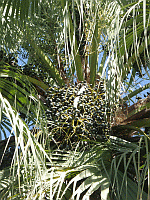




|

hawaiianoasis.com
Plant Family: Belongs to the Arecaceae or Palm family, which includes the Coconut Palm (Cocos nucifera), Century Palm (Corypha umbraculifera) and Royal Palm (Roystonea oleracea).
Description: Slow growing, attractive, solitary, medium-size palm, up to 15 m tall (50 ft) in native habitat, more commonly 8-9 m (25-30 ft), spreading 3-4 m (10-12 ft); crown usually with a skirt of dead leaves; trunk brown, gray on older trees, erect, grows to about 0.5 m in diameter (1.5 ft), wider at base; leaves up to 2 m in diameter (6 ft), form dense canopy on trunk, are deeply divided into about 75 segments with distinctive, drooping tips that give graceful fountain-like appearance (hence its other common name, Chinese Fountain Palm); petioles armed with sharp spines; has long tap root and can survive extended periods of drought; flowers small, white, inconspicuous, borne on 2 m (6 ft) inflorescences hidden within crown; fruit small, oval or round, olive-like, 1.3-2.6 cm long (0.5-1 in), turning blue to blue-gray when ripe; L. chinensis subglobosa is a dwarf variety.
Natural Habitat: Thrives in open forest, part shade to sunny locations, on wide range of soil conditions; propagated by seed, which, with adequate warmth, will germinate in 1- 2 months time.
Origin and Distribution: Native to southern Japan, Taiwan and islands of the South China Sea; introduced variously in warm temperate to tropical regions as ornamental.
Uses: Primarily ornamental; becoming increasingly popular for use in landscapes, medians and along freeways in warm temperate climates, including Florida and California; also used in interiorscapes, especially in shopping malls; young specimens used as ground cover, particularly dwarf variety
References:
Jack Scheper. Livistona chinensis. Floridata.com. Tallahassee, Florida, 1996
Edward F. Gilman and Dennis G. Watson. Livistona chinensis, Chinese Fan Palm. USDA Forest Service, Washington, D.C. 1993
|



